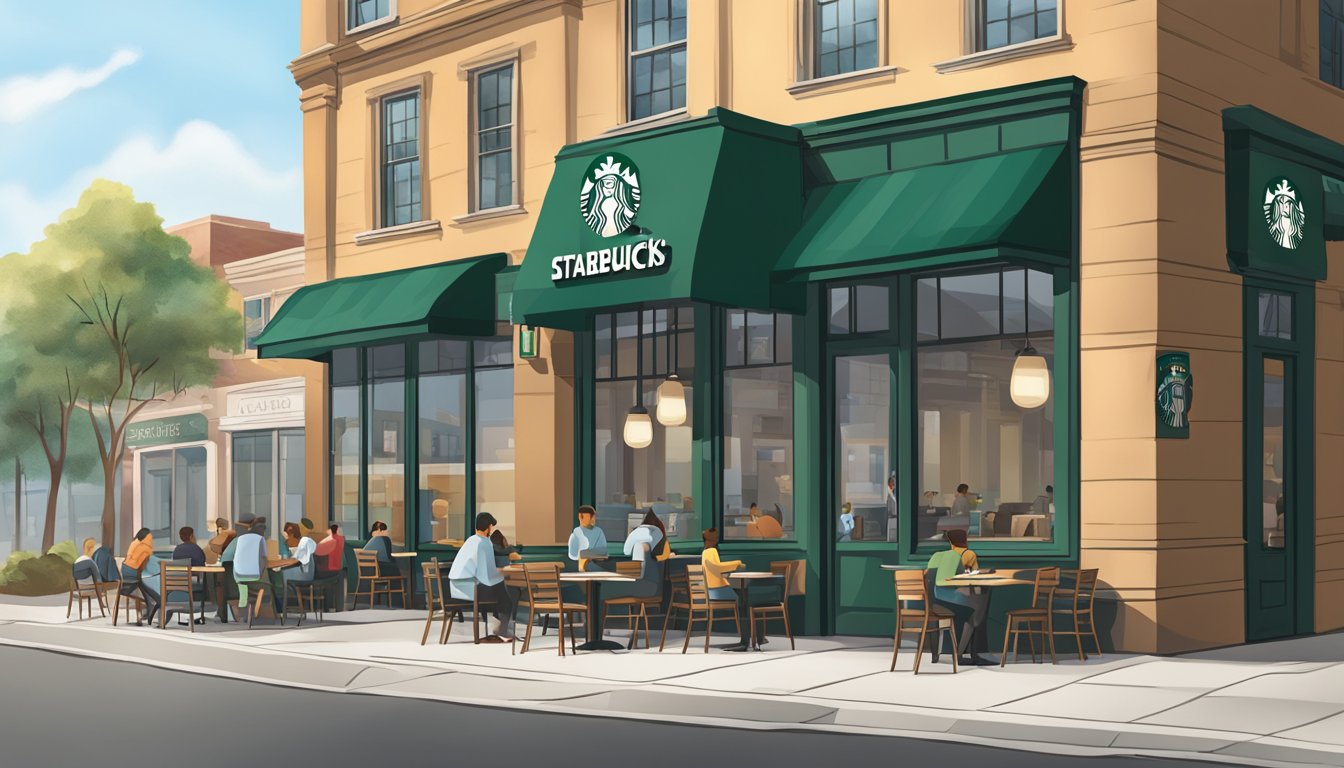Starbucks, the global coffee chain giant, has become a ubiquitous presence in cities worldwide. Its expansion into breakfast offerings has raised questions about the impact on local breakfast businesses. While Starbucks’ presence can boost foot traffic and attract new customers to an area, it also poses challenges for independent cafes and restaurants.
The “Starbucks Effect” has been shown to increase local business innovation and property values in neighborhoods where the chain opens new locations. This phenomenon suggests that Starbucks’ arrival can spark economic growth and development. However, the impact on existing breakfast establishments is more complex, with some local businesses facing increased competition and potential displacement.
Starbucks’ breakfast menu, featuring items like breakfast sandwiches and pastries, directly competes with traditional local offerings. Some independent cafes have adapted by enhancing their unique offerings or focusing on specialized breakfast items to differentiate themselves. The long-term effects on local breakfast businesses vary depending on factors such as location, customer loyalty, and the ability to adapt to changing market dynamics.
Starbucks’ Business Model and Market Impact

Starbucks’ business model hinges on premium products, strategic expansion, and creating unique customer experiences. This approach has significantly impacted local markets and shaped consumer habits worldwide.
Expansion Strategies and Local Penetration
Starbucks employs aggressive expansion tactics to penetrate local markets. The company targets high-traffic urban areas and suburbs, often placing multiple stores within close proximity. This saturation strategy aims to maximize convenience for customers and capture market share.
Starbucks adapts its offerings to suit local tastes while maintaining brand consistency. In China, for example, stores offer green tea-flavored beverages alongside traditional coffee drinks. This localization helps Starbucks integrate into diverse communities and compete with local cafes.
The company’s global presence spans over 80 countries with more than 36,000 locations. This extensive network allows Starbucks to leverage economies of scale in sourcing and operations, giving it a competitive edge over smaller local businesses.
Innovation and Product Diversification
Starbucks continually innovates its menu to stay ahead of market trends and meet evolving consumer preferences. The company regularly introduces seasonal drinks, limited-time offers, and new food items to keep customers engaged and drive repeat visits.
Product diversification extends beyond beverages. Starbucks has expanded into:
- Ready-to-drink products sold in grocery stores
- Coffee beans and brewing equipment for home use
- Digital offerings like mobile ordering and payment apps
This multi-channel approach helps Starbucks capture additional revenue streams and maintain relevance in a competitive market. The company’s focus on innovation often sets trends that smaller local cafes struggle to match.
Starbucks as a ‘Third Place’ in Communities
Starbucks positions itself as a “third place” between home and work, fostering a sense of community. Store designs feature comfortable seating, free Wi-Fi, and a welcoming atmosphere to encourage customers to linger.
This strategy has transformed coffee shop culture in many areas. Starbucks locations often become informal meeting spots, study areas, and remote work hubs. The company’s emphasis on creating a distinct experience sets it apart from traditional diners and local breakfast spots.
Starbucks also engages in community initiatives, such as local hiring programs and partnerships with non-profits. These efforts help integrate the brand into the fabric of local communities, building customer loyalty and positive brand associations.
Local Breakfast Businesses: Adapting and Competing

Local breakfast businesses face both challenges and opportunities in competing with Starbucks. These establishments are finding innovative ways to differentiate themselves and capitalize on community connections.
Challenges and Opportunities for Local Coffee Shops
Local coffee shops confront significant hurdles when competing with Starbucks’ extensive reach and resources. However, they also possess unique advantages. Many customers seek authentic, community-focused experiences that small businesses excel at providing.
Local shops can quickly adapt their menus and atmospheres to reflect neighborhood preferences. This flexibility allows them to create distinctive offerings that resonate with their specific clientele.
The “shop local” movement has bolstered independent cafes. Consumers increasingly value supporting businesses that contribute directly to their community’s economy and culture.
Entrepreneurship and Neighborhood Collaboration
Local breakfast businesses are fostering entrepreneurship through creative partnerships. Some cafe owners collaborate with other neighborhood establishments to cross-promote and expand their customer base.
In certain regions, collaborations between coffee shops and local figures have shown remarkable success. A study revealed a 29.7% increase in startups in areas where Starbucks partnered with Earvin “Magic” Johnson.
This model inspires local businesses to seek out community leaders and influencers for mutually beneficial partnerships. Such collaborations can enhance visibility and drive foot traffic.
Price Competition and Quality of Offerings
Local breakfast spots often differentiate themselves through high-quality, unique menu items. While they may struggle to match Starbucks’ prices, many focus on superior ingredients and craftsmanship.
Some cafes emphasize locally-sourced products or house-made specialties. Others offer extensive breakfast menus that go beyond typical coffee shop fare.
Pricing strategies vary, with some local businesses choosing to compete directly on price for basic items while charging premiums for specialty offerings. This approach allows them to cater to budget-conscious customers while still showcasing their unique value proposition.
Economic Implications for Local Economies

Starbucks’ presence in communities extends beyond serving coffee, impacting local economies in multifaceted ways. The company’s expansion strategy and role as a “third place” contribute to economic growth, property values, and community development.
The ‘Starbucks Effect’ on Property Values and Rental Costs
The arrival of a Starbucks often signals positive changes for property values in the surrounding area. Real estate prices tend to rise as the coffee chain’s presence attracts other businesses and foot traffic. This phenomenon, known as the “Starbucks Effect,” can lead to increased rental costs for both residential and commercial properties.
Neighborhoods with new Starbucks locations often experience:
• 5-10% increase in property values within 1-2 years
• Higher demand for nearby retail spaces
• Improved perception of area desirability
While beneficial for property owners, rising costs can pose challenges for existing small businesses and residents.
Impact on Local Economy and Employment
Starbucks’ entry into a community typically generates economic activity beyond its own operations. Research indicates that a new Starbucks in an area without existing coffee shops can lead to the creation of 1.1 to 3.5 new companies annually over the following seven years.
Key economic impacts include:
• Direct job creation within Starbucks stores
• Indirect employment through supply chain and supporting services
• Increased foot traffic benefiting nearby businesses
• Attraction of complementary businesses to the area
These effects can contribute to local economic growth and diversification.
Community Organization and Local Economy Stimulus
Starbucks often serves as a catalyst for community organization and economic stimulus. The company’s role as a “third place” – a social space separate from home and work – fosters connections and idea-sharing among locals.
Economic benefits of this community hub effect:
• Increased collaboration opportunities for entrepreneurs
• Informal networking leading to business partnerships
• Community events and initiatives hosted at Starbucks locations
Past partnerships, like the one with Earvin “Magic” Johnson from 1998 to 2010, demonstrated even stronger impacts. Stores opened under this initiative spurred an average of 4.3 additional startups per year in their communities.
Cultural and Social Dynamics

Starbucks has transformed coffee shops into essential community spaces, influencing social interactions and neighborhood dynamics. The brand’s presence often sparks debates about cultural authenticity and local character.
The Role of Coffee Shops in Social Networking
Coffee shops serve as “third places” – social spaces separate from home and work. Starbucks has capitalized on this concept, creating environments conducive to meetings, studying, and remote work.
Their stores offer free Wi-Fi and comfortable seating, encouraging longer visits and social interactions. This has made Starbucks a popular meetup spot for friends, colleagues, and community groups.
The chain’s ubiquity means people can find familiar spaces in unfamiliar locations, providing a sense of comfort and consistency for travelers and newcomers to an area.
Gentrification and Its Effects on Neighborhoods
The arrival of a Starbucks often signals neighborhood changes. It can be seen as a harbinger of gentrification, attracting more upscale businesses and residents.
This process can lead to increased property values and improved amenities. However, it may also result in the displacement of long-time residents and local businesses due to rising costs.
Starbucks’ presence can alter the character of a neighborhood, sometimes at the expense of existing community bonds and local cultural identities.
The Instagrammable Appeal: Starbucks vs. Local Businesses
Starbucks has mastered the art of creating visually appealing products that are perfect for social media sharing. Their seasonal drinks and eye-catching cups often become viral sensations.
This focus on “Instagrammable” offerings has influenced local cafes, pushing them to innovate and create their own photogenic menu items.
While some local businesses struggle to compete with Starbucks’ marketing power, others have found success by emphasizing their unique, artisanal qualities that contrast with Starbucks’ mass-produced image.
Social media visibility has become crucial for both Starbucks and independent cafes, shaping menu decisions and interior designs to cater to the Instagram-savvy customer base.
Starbucks’ Product Influence on Market Trends

Starbucks has significantly shaped coffee industry trends through innovative drinks, menu offerings, and ethical sourcing practices. The company’s influence extends beyond its own cafes, impacting local businesses and consumer preferences.
Starbucks’ Signature Drinks and Seasonal Offerings
Starbucks continually introduces new and creative beverages that capture consumer attention. The Cake Batter Frappuccino and Vanilla Bean Crème Frappuccino exemplify their ability to blend familiar flavors with unique coffee experiences.
Seasonal offerings like Pumpkin Spice Latte have become cultural phenomena, driving sales and inspiring imitations across the industry. These limited-time drinks create buzz and encourage repeat visits.
Starbucks’ use of flavored syrups, such as Hazelnut Syrup, has popularized customized drink orders. This trend has spread to local cafes, with customers now expecting a wide range of flavor options.
Influence on Local Coffee Shop Menus
Local coffee shops often adapt their menus to compete with Starbucks’ popular offerings. Many now feature their own versions of frappuccinos, lattes, and seasonal specials.
Some cafes have embraced the “secret menu” concept popularized by Starbucks. Drinks like “Liquid Cocaine” – a strong espresso-based beverage – have emerged as local interpretations of Starbucks-inspired concoctions.
To differentiate themselves, some local shops focus on artisanal methods and unique local ingredients. This approach aims to attract customers seeking alternatives to Starbucks’ standardized offerings.
Fair Trade and Ethical Sourcing Impact
Starbucks’ commitment to fair trade and ethical sourcing has raised consumer awareness about coffee origins. This has led to increased demand for sustainably sourced coffee across the industry.
Many local cafes now highlight their own ethical sourcing practices to appeal to socially conscious consumers. This shift has created new market opportunities for small-scale, fair trade coffee producers.
Starbucks’ influence has also led to greater transparency in the coffee supply chain. Consumers increasingly expect information about coffee origin and production methods, prompting businesses to adapt their sourcing and marketing strategies.
Conclusion

Starbucks’ entry into local breakfast markets has created both challenges and opportunities. The global coffee chain’s presence has intensified competition, pushing local establishments to innovate and improve their offerings.
Many small businesses have adapted by emphasizing unique, locally-sourced ingredients and personalized service. This differentiation strategy has allowed them to retain loyal customers and attract new ones seeking authentic experiences.
Starbucks has also stimulated overall breakfast consumption in many areas. The increased foot traffic and awareness of morning dining options have benefited the entire breakfast sector.
Collaborations between Starbucks and local suppliers have strengthened regional economies. These partnerships have created new jobs and supported local farmers and food producers.
The long-term impact on local breakfast businesses varies by location. In some areas, Starbucks has become a complementary player rather than a direct competitor. In others, it has reshaped the market dynamics significantly.
Ultimately, the success of local breakfast establishments depends on their ability to adapt, innovate, and leverage their unique strengths. Those that embrace change and focus on quality and community connections are best positioned to thrive alongside Starbucks.




